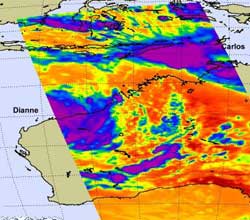NASA sees tropical cyclone double-trouble for Australia

NASA\'s Aqua satellite passed over Australia on Feb. 16 at 05:17 UTC (12:17 a.m. EST/ 2:47 p.m. Australia/Darwin local time). The Atmospheric Infrared Sounder (AIRS) instrument on Aqua captured an infrared image of Tropical Storm Dianne (left) and Tropical Storm Carlos (right) and found each to have strong convection (purple) with cloudtop temperatures as cold as -52C. Credit: NASA JPL, Ed Olsen<br>
NASA's Aqua satellite passed over Australia today, Feb. 16 at 05:17 UTC (12:17 a.m. EST/ 2:47 p.m. Australia/Darwin local time. The Atmospheric Infrared Sounder (AIRS) instrument captured an infrared image of both tropical storms and found each to have strong convection (rapidly rising air that forms the thunderstorms that power a tropical cyclone). Convection was so strong in Carlos and Dianne that the cloud tops of the thunderstorms within were as cold as or colder than -52 Celsius/ -63 Fahrenheit.
At 0900 UTC (4 a.m. EST/6:30 p.m. Australia/Darwin local time) Tropical Storm Carlos, formerly System 99S, had maximum sustained winds near 35 knots (40 mph/64 kmh) and its center at that time was 15 miles (24 km) south of Darwin, Australia, near 12.7 South and 130.9 East. Eight hours later, by 12 p.m. EST (2:30 a.m. Feb. 17 Australia/Darwin local time), Carlos' center had moved southeast and was inland near Middle Point. Carlos was moving toward the southeast but is expected to turn to the southwest.
Carlos was bringing bands of rainfall to Cape Don, Snake Bay, Cape Fouroroy, and inland over an area that includes Annaburroo, Emerald Springs and Batchelor. For radar from the Australian Bureau of Meteorology, go to: › http://www.bom.gov.au/products/IDR632.loop.shtml.
A Cyclone Warning for Carlos is in effect for coastal areas from Daly River Mouth to Goulburn Island, including Darwin, Croker Island and the Tiwi Islands. A Cyclone Watch continues for coastal areas from Port Keats to Daly River Mouth. The Joint Typhoon Warning Center and Australian Bureau of Meteorology expect Carlos to eventually track southwest over land for the next several days.
Near Western Australia, System 97S intensified into Tropical Storm Dianne overnight. On Feb. 16 at 1500 UTC (10 a.m. EST/12:30 a.m. Feb. 17, Australia/Darwin local time), Tropical Storm Dianne had maximum sustained winds near 40 knots (46 mph / 74 kmh). It was still over open waters in the Southern Indian Ocean, near 18.9 South latitude and 111.3 East longitude, about 250 nautical miles (287 miles/463 km) northwest of Learmonth, Australia.
A Cyclone Watch is currently in effect for coastal areas of Western Australia from Exmouth to Cape Cuvier. During the morning hours (Eastern Time/U.S.) bands of showers were pushing southeast from Dianne from Pardoo (in the east) through Port Hedland southwest to Exmouth. It is currently drifting to the northeast but is expected to loop and move south then southwest after the next day or two.
The Joint Typhoon Warning Center expects Dianne to continue strengthening under an environment of warm sea surface temperatures and low wind shear for the next three days before running into adverse conditions. During that time, however, it is forecast to reach hurricane force and bring gusty winds and heavy rainfall to Learmonth as its center passes to the west.
Media Contact
All latest news from the category: Earth Sciences
Earth Sciences (also referred to as Geosciences), which deals with basic issues surrounding our planet, plays a vital role in the area of energy and raw materials supply.
Earth Sciences comprises subjects such as geology, geography, geological informatics, paleontology, mineralogy, petrography, crystallography, geophysics, geodesy, glaciology, cartography, photogrammetry, meteorology and seismology, early-warning systems, earthquake research and polar research.
Newest articles

Superradiant atoms could push the boundaries of how precisely time can be measured
Superradiant atoms can help us measure time more precisely than ever. In a new study, researchers from the University of Copenhagen present a new method for measuring the time interval,…

Ion thermoelectric conversion devices for near room temperature
The electrode sheet of the thermoelectric device consists of ionic hydrogel, which is sandwiched between the electrodes to form, and the Prussian blue on the electrode undergoes a redox reaction…

Zap Energy achieves 37-million-degree temperatures in a compact device
New publication reports record electron temperatures for a small-scale, sheared-flow-stabilized Z-pinch fusion device. In the nine decades since humans first produced fusion reactions, only a few fusion technologies have demonstrated…





















